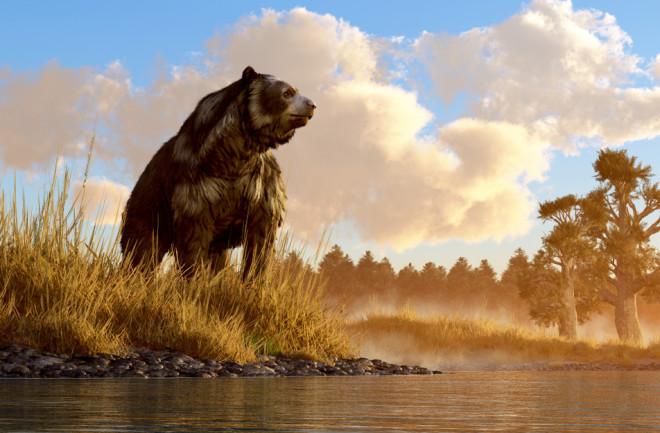Today's biggest predators are a fearsome force. While sperm whales dive deep into the oceans to make meals out of giant squid, orcas occasionally punch above their weight, taking on blue whales (the largest animals to ever exist). Meanwhile, polar bears and brown bears dominate the land — taking down seals and walruses on the one hand and moose and deer on the other — topping the list of large land predators alive on our planet.
But the size of ancient predators puts current carnivores to shame, with true giants swimming the oceans, flying the skies, and walking the plains and forests of the prehistoric world. Some of these behemoths are well-known from movies and books, while others are more obscure, known mostly by scientists.
Here we’ve taken a look at some of the largest mega-predators of the ancient world.
Read More: How Do Scientists Reconstruct What Dinosaurs Looked Like?
1. Otodus megalodon
Megalodons lived at some point during the Miocene and Pliocene epochs, which together spanned from 23 million to 2.6 million years ago, though Hollywood has recently brought them back from extinction.
How Big Was Megalodon?
These ancient sharks make modern sharks look like minnows. Some megalodons reached up to 60 feet long, a length three to four times that of modern-day great whites. Their jaws even opened wide enough that the species, Otodus megalodon, would've been able to swallow a standing human whole — in a single bite — and then some.
What Did Megalodon Eat?
Without humans around for food, however, these sharks, the largest fish to ever live, likely fed on other fish, baleen whales, and ancestral forms of orcas.
Read More: The Mystery of the Megalodon And What Scientists Know
2. Quetzalcoatlus northropi
While most of the creatures on this list traveled by land or by sea, Quetzalcoatlus northropi took to the skies. These giant pterosaurs — the largest yet discovered — likely fed on fish and small aquatic prey, living their lives like massive, modern-day herons, according to a press release from the Natural History Museum in London.
What Is a Quetzalcoatlus northropi's Wingspan?
Though their prey wasn't that intimidating, Quetzalcoatlus northropi's wings were. The wingspan of these Late Cretaceous creatures, which were first discovered in Texas in the 1970s, may have been as many as 40 feet long — making the 67-million-year-old species the largest airborne predator to ever take flight.
Read More: How Big Was Quetzalcoatlus And Other Giant Pterosaurs?
3. Pliosaurs
A number of pliosaurs, ancient marine reptiles including Kronosaurus queenslandicus and Pliosaurus macromerus, reached massive lengths — more than 30 feet long. Lorrainosaurus keileni even had mandibles over four feet long.
When Did Pliosaurs Live?
These pliosaurs rose to the position of apex predators in portions of the Jurassic and Cretaceous periods, which spanned from around 200 million to 66 million years ago. The most massive came from the Thalassophonea clade — a name that translates to "sea murderers."
What Did Pliosaurs Eat?
Pliosaurus funkei, a pliosaur species discovered in the Arctic islands of Svalbard in 2009 and previously known as "Predator X," may have had the highest bite force of any creature ever. With their enormous maws, the diet of this large pliosaur species would have included large cephalopods, large fish, and other large reptiles.
Read More: 5 of the Most Interesting Prehistoric Marine Reptiles
4. Andrewsarchus mongoliensis
The largest land mammal may have been, paradoxically, a whale. In fact, this massive hoof-toed creature, Andrewsarchus mongoliensis, came from an order of mammals called artiodactyls — a group that includes everything from ungulates to pigs and whales.
How Big Was Andrewsarchus?
No slouches when it came to size, A. mongoliensis may have stood about six feet tall and about 12 feet long, according to the American Museum of Natural History.
When Did Andrewsarchus Live?
Scientists think that these predators, which lived in the Middle Eocene in East Asia around 45 million years ago, were most closely related to modern-day whales and hippos.
Read More: 5 Of The Biggest Animals To Ever Live On Earth
5. Short-Faced Bears
The dominant size of A. mongoliensis may be under dispute, however, as two species of short-faced bears may have been larger, depending on how scientists measure them.
How Big Were Short-Faced Bears?
Of these two species — Arctotherium angustidens and Arctodus simus — the latter was a particularly fierce predator due to its long legs. Standing upright at around 12 feet tall, A. simus was likely the fastest bear to ever live.
When Did Short-Faced Bears Go Extinct?
Both bears were active in the Americas during the Pleistocene, a period from around 2.6 million to 11,700 years ago. This timing aligns with the last Ice Age, a period when gigantic glaciers and ice sheets stretched across the globe.
Read More: Ice Ages: What Causes the Earth to Freeze Over Every Few Million Years?
6. Tyrannosaurus rex
When thinking of large predators, Tyrannosaurus rex is often on the tip of most people’s tongues.
Is T. rex the Biggest Dinosaur?
For a long time, it was considered the largest carnivorous dinosaur. However, discoveries in recent years have revealed that other theropods like Spinosaurus and Giganotosaurus may have been a bit bigger than T. rex.
The trouble with these contenders is that paleontologists haven’t found nearly as many of their fossils as those of T. rex. But that didn't stop Jurassic Park: Dominion from portraying Giganotosaurus as an absolute behemoth.
Regardless of their specific ranking, all three dinosaurs are estimated to have been about 40 feet from head to tail, meaning there was no shortage of massive dinosaurs at the top of the ancient food-chain.
What Did T. rex Eat?
These classic predators chewed on everything from duck-billed dinosaurs like the 10-foot tall Edmontosaurus annectens to Triceratops to other Tyrannosaurus at the end of the Cretaceous, around 66 million years ago.

